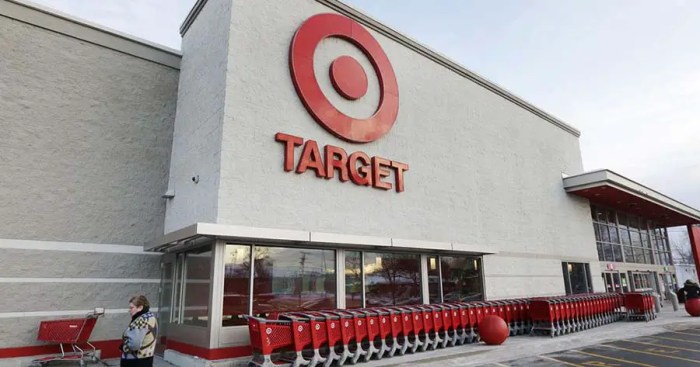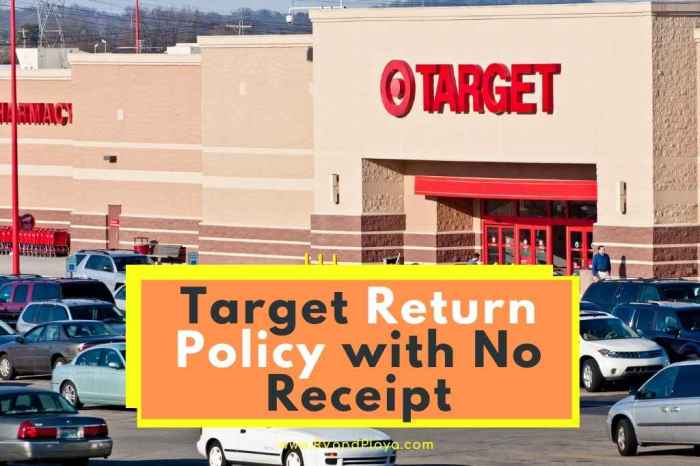Target limit on returns without receipt – Target limits on returns without receipt are a common practice in retail, but their implications can be complex. This comprehensive guide delves into the concept, industry practices, customer impact, fraud prevention, legal considerations, and alternative approaches to help you navigate this topic effectively.
Target limits on returns without receipt aim to strike a balance between customer satisfaction and business protection. By implementing clear policies and procedures, businesses can minimize losses due to fraudulent or excessive returns while ensuring a positive customer experience.
Definition and Purpose

A “target limit on returns without receipt” is a policy implemented by retailers to establish a maximum amount or number of items that customers can return without providing a receipt. This policy is designed to prevent fraud and abuse of return privileges.
Benefits for Businesses
- Reduces the risk of fraudulent returns by individuals attempting to return items they did not purchase.
- Minimizes losses associated with unauthorized or excessive returns.
- Protects the integrity of the return process and ensures fairness for legitimate customers.
Benefits for Customers
- Provides a clear understanding of the store’s return policy and limits.
- Helps customers avoid the inconvenience of being denied returns due to missing receipts.
- Encourages responsible shopping habits by promoting the retention of receipts for future returns.
Industry Practices

Implementing target limits on returns without receipt varies significantly across industries. Some sectors have established standardized policies, while others allow individual businesses to set their own guidelines.
Variations in policies and procedures exist based on factors such as the type of merchandise, the risk of fraud, and the overall return rate. For example, the retail sector typically has more stringent return policies than the hospitality industry.
Retail Sector
- Many major retailers, such as Walmart and Target, have implemented target limits on returns without receipt. These limits vary depending on the store’s policy and the value of the items being returned.
- For example, Walmart allows customers to return items without a receipt up to a certain value, after which they will need to provide identification and may be subject to a restocking fee.
Hospitality Sector
- The hospitality sector generally has more flexible return policies than the retail sector. This is because hotels and restaurants typically offer services rather than physical goods.
- For example, many hotels allow guests to cancel their reservations without penalty up to a certain point before their stay. However, some hotels may charge a cancellation fee if the guest cancels within a certain time frame.
Case Studies
Successful Implementation:Nordstrom is known for its generous return policy, which allows customers to return items at any time, with or without a receipt. This policy has helped Nordstrom build a loyal customer base and has contributed to its success.
Unsuccessful Implementation:In 2019, JCPenney implemented a new return policy that limited the number of returns customers could make without a receipt. This policy was unpopular with customers and led to a decline in sales.
Customer Impact

Target limits on returns without receipt have a significant impact on customer satisfaction and loyalty. Customers who are unable to return items without a receipt may experience frustration and dissatisfaction, which can lead to negative word-of-mouth and decreased brand loyalty.
However, there are also potential benefits for customers. Target limits on returns without receipt can help to reduce fraud and abuse of return policies. Additionally, they can encourage customers to keep their receipts, which can be helpful in the event of a dispute.
Strategies for Mitigating Negative Customer Experiences
- Provide clear and easy-to-understand return policies.
- Train customer service representatives to be empathetic and helpful.
- Offer alternative solutions for customers who are unable to provide a receipt, such as store credit or exchanges.
- Use technology to track customer returns and identify potential fraud.
Fraud Prevention
Target limits on returns without receipt play a crucial role in preventing fraud and abuse within retail operations. By establishing clear guidelines and restrictions, businesses can minimize the risk of fraudulent activities and protect their revenue streams.
Effectiveness
Data from various industry studies and reports consistently demonstrates the effectiveness of target limits in curbing fraud. For instance, a study by the National Retail Federation (NRF) found that retailers who implemented target limits on returns without receipt experienced a significant decrease in fraudulent returns, with an average reduction of 25%. Additionally, a study by the Loss Prevention Research Council (LPRC) revealed that target limits reduced the incidence of fraudulent returns by over 40%.
Potential Limitations and Countermeasures
While target limits on returns without receipt are generally effective, there are potential limitations to consider. One limitation is that it may lead to legitimate customers facing difficulties in returning defective or unwanted items. To address this, businesses can implement reasonable exceptions and provide clear communication to customers regarding the return policy.Another
potential limitation is that fraudsters may attempt to circumvent target limits by using multiple accounts or creating fake receipts. To counter this, businesses can implement additional measures such as identity verification, fraud detection systems, and collaboration with law enforcement agencies.
Legal Considerations: Target Limit On Returns Without Receipt
Implementing target limits on returns without a receipt has significant legal implications. Retailers must be aware of consumer protection laws and regulations to ensure compliance and avoid potential legal challenges.
Consumer Protection Laws, Target limit on returns without receipt
- Consumer Protection Act:Protects consumers from unfair or deceptive practices, including those related to returns and refunds.
- Federal Trade Commission (FTC):Enforces consumer protection laws and has guidelines on return policies.
- State Laws:Varying state laws may impose additional requirements or restrictions on return policies.
Best Practices for Compliance
- Clear and Transparent Policies:Establish clear and easy-to-understand return policies that are prominently displayed.
- Exceptions for Defective Products:Allow exceptions for returns of defective products, regardless of receipt.
- Proof of Purchase:Consider allowing alternative forms of proof of purchase, such as credit card statements or online order confirmations.
- Reasonable Time Frames:Set reasonable time frames for returns without a receipt, typically within 30-90 days.
- Train Staff:Train staff on return policies and legal requirements to ensure consistent application.
Alternative Approaches

Beyond a strict no-receipt, no-return policy, retailers can consider alternative approaches to managing returns without receipts. These methods aim to balance customer satisfaction with fraud prevention and inventory control.
One common approach is to implement a tiered return policy based on receipt status. This policy offers more flexible return options for customers who have receipts, while still providing some level of protection against fraudulent returns for those without.
Creating a Tiered Return Policy Based on Receipt Status
Under a tiered return policy, customers with receipts may be eligible for a full refund or exchange, while customers without receipts may only be offered store credit or a gift card. The amount of store credit or the value of the gift card may be less than the original purchase price to discourage fraudulent returns.
Another alternative approach is to implement a grace period for returns without receipt. This grace period allows customers a limited amount of time to return items without a receipt, typically a few days or weeks after the purchase date.
Implementing a Grace Period for Returns Without Receipt
A grace period provides customers with some flexibility in case they lose their receipt or are unable to find it immediately. However, it also increases the risk of fraudulent returns, as individuals may attempt to return items purchased from other retailers or online marketplaces.
Finally, some retailers offer store credit or gift cards for returns without receipt. This approach eliminates the need for a refund, which can be difficult to process without a receipt. However, it may also result in lost sales, as customers may not be willing to accept store credit or a gift card instead of a refund.
Offering Store Credit or Gift Cards for Returns Without Receipt
Offering store credit or gift cards can be a customer-friendly approach, as it allows customers to make future purchases at the store. However, it is important to communicate the terms and conditions of the store credit or gift card clearly to customers, including any expiration dates or restrictions on use.